(转)对存储过程进行加密和解密(SQL 2008/SQL 2012)
原文地址:http://www.cnblogs.com/wghao/archive/2012/12/30/2837642.html
开始:
在网络上,看到有SQL Server 2000和SQL Server 2005 的存储过程加密和解密的方法,后来分析了其中的代码,发现它们的原理都是一样的。后来自己根据实际的应用环境,编写了两个存储过程,一个加密存储过程(sp_EncryptObject),和一个解密存储过程(sp_EncryptObject),它们可以应用于SQL Server中的储过程,函数,视图,以及触发器。
感觉这两个存储过程蛮有意思的,拿来与大家分享;如果你看过类似的,就当作重温一下也好。
用于加密的存储过程 (sp_EncryptObject) :
存储过程(sp_EncryptObject)加密的方法是在存储过程,函数,视图的“As”位置前加上“with encryption”;如果是触发器,就在“for”位置前加“with encryption”。
如果触发器是{ AFTER | INSTEAD OF} 需要修改下面代码"For"位置:
if objectproperty(object_id(@Object),'ExecIsAfterTrigger')=0 set @Replace='As' ; else set @Replace='For ';
存储过程完成代码:

Use master Go if object_ID('[sp_EncryptObject]') is not null Drop Procedure [sp_EncryptObject] Go create procedure sp_EncryptObject ( @Object sysname='All' ) as /* 当@Object=All的时候,对所有的函数,存储过程,视图和触发器进行加密 调用方法: 1. Execute sp_EncryptObject 'All' 2. Execute sp_EncryptObject 'ObjectName' */ begin set nocount on if @Object <>'All' begin if not exists(select 1 from sys.objects a where a.object_id=object_id(@Object) And a.type in('P','V','TR','FN','IF','TF')) begin --SQL Server 2008 raiserror 50001 N'无效的加密对象!加密对象必须是函数,存储过程,视图或触发器。' --SQL Server 2012 --throw 50001, N'无效的加密对象!加密对象必须是函数,存储过程,视图或触发器。',1 return end if exists(select 1 from sys.sql_modules a where a.object_id=object_id(@Object) and a.definition is null) begin --SQL Server 2008 raiserror 50001 N'对象已经加密!' --SQL Server 2012 --throw 50001, N'对象已经加密!',1 return end end declare @sql nvarchar(max),@C1 nchar(1),@C2 nchar(1),@type nvarchar(50),@Replace nvarchar(50) set @C1=nchar(13) set @C2=nchar(10) declare cur_Object cursor for select object_name(a.object_id) As ObjectName,a.definition from sys.sql_modules a inner join sys.objects b on b.object_id=a.object_id and b.is_ms_shipped=0 and not exists(select 1 from sys.extended_properties x where x.major_id=b.object_id and x.minor_id=0 and x.class=1 and x.name='microsoft_database_tools_support' ) where b.type in('P','V','TR','FN','IF','TF') and (b.name=@Object or @Object='All') and b.name <>'sp_EncryptObject' and a.definition is not null order by Case when b.type ='V' then 1 when b.type ='TR' then 2 when b.type in('FN','IF','TF') then 3 else 4 end,b.create_date,b.object_id open cur_Object fetch next from cur_Object into @Object,@sql while @@fetch_status=0 begin Begin Try if objectproperty(object_id(@Object),'ExecIsAfterTrigger')=0 set @Replace='As' ; else set @Replace='For '; if (patindex('%'+@C1+@C2+@Replace+@C1+@C2+'%',@sql)>0) begin set @sql=Replace(@sql,@C1+@C2+@Replace+@C1+@C2,@C1+@C2+'With Encryption'+@C1+@C2+@Replace+@C1+@C2) end else if(patindex('%'+@C1+@Replace+@C1+'%',@sql)>0) begin set @sql=Replace(@sql,@C1+@Replace+@C1,@C1+'With Encryption'+@C1+@Replace+@C1) end else if(patindex('%'+@C2+@Replace+@C2+'%',@sql)>0) begin set @sql=Replace(@sql,@C2+@Replace+@C2,@C2+'With Encryption'+@C2+@Replace+@C2) end else if(patindex('%'+@C2+@Replace+@C1+'%',@sql)>0) begin set @sql=Replace(@sql,@C2+@Replace+@C1,@C1+'With Encryption'+@C2+@Replace+@C1) end else if(patindex('%'+@C1+@C2+@Replace+'%',@sql)>0) begin set @sql=Replace(@sql,@C1+@C2+@Replace,@C1+@C2+'With Encryption'+@C1+@C2+@Replace) end else if(patindex('%'+@C1+@Replace+'%',@sql)>0) begin set @sql=Replace(@sql,@C1+@Replace,@C1+'With Encryption'+@C1+@Replace) end else if(patindex('%'+@C2+@Replace+'%',@sql)>0) begin set @sql=Replace(@sql,@C2+@Replace,@C2+'With Encryption'+@C2+@Replace) end set @type = case when object_id(@Object,'P')>0 then 'Proc' when object_id(@Object,'V')>0 then 'View' when object_id(@Object,'TR')>0 then 'Trigger' when object_id(@Object,'FN')>0 or object_id(@Object,'IF')>0 or object_id(@Object,'TF')>0 then 'Function' end set @sql=Replace(@sql,'Create '+@type,'Alter '+@type) Begin Transaction exec(@sql) print N'已完成加密对象('+@type+'):'+@Object Commit Transaction End Try Begin Catch Declare @Error nvarchar(2047) Set @Error='Object: '+@Object+@C1+@C2+'Error: '+Error_message() Rollback Transaction print @Error print @sql End Catch fetch next from cur_Object into @Object,@sql end close cur_Object deallocate cur_Object end Go exec sp_ms_marksystemobject 'sp_EncryptObject' --标识为系统对象 go
如果SQL Server 2012,请修改下面两个位置的代码。在SQL Server 2012,建议在使用throw来代替raiserror。
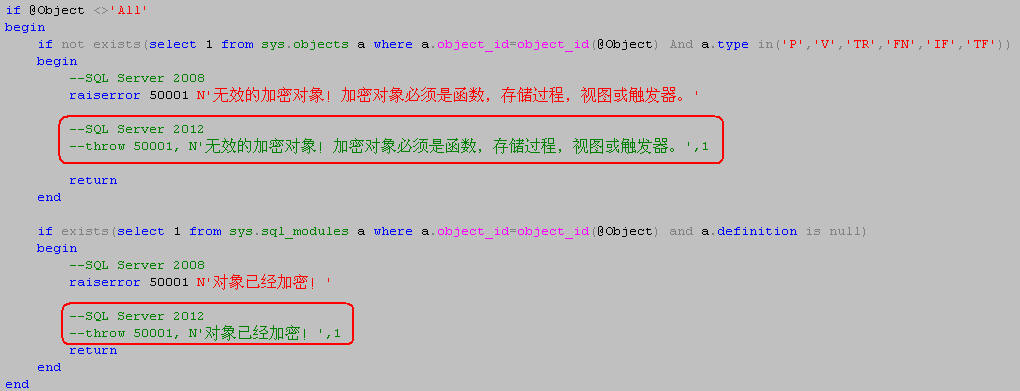
解密方法:
解密过程,最重要采用异或方法:
[字符1]经过函数 fn_x(x)加密变成[加密后字符1],如果我们已知[加密后字符1],反过来查[字符1],可以这样:
[字符1] = [字符2] ^ fn_x([字符2]) ^ [加密后字符1]
这里我列举一个简单的例子:
--创建加密函数(fn_x) if object_id('fn_x') is not null drop function fn_x go create function fn_x ( @x nchar(1) )returns nchar(1) as begin return(nchar((65535-unicode(@x)))) end go declare @nchar_1_encrypt nchar(1),@nchar_2 nchar(1) --对字符'A'进行加密,存入变量@nchar_1_encrypt set @nchar_1_encrypt=dbo.fn_x(N'A') --參考的字符@nchar_2 set @nchar_2='x' --算出@nchar_1_encrypt 加密前的字符 select nchar(unicode(@nchar_2)^unicode(dbo.fn_x(@nchar_2))^unicode(@nchar_1_encrypt)) as [@nchar_1] /* @nchar_1 -------------------- A */
[注]: 从SQL Server 2000至 SQL Server 2012 采用异或方法都可以解密
用于解密的存储过程(sp_DecryptObject):

Use master Go if object_ID('[sp_DecryptObject]') is not null Drop Procedure [sp_DecryptObject] Go create procedure sp_DecryptObject ( @Object sysname, --要解密的对象名:函数,存储过程,视图或触发器 @MaxLength int=4000 --评估内容的长度 ) as set nocount on /* 1. 解密 */ if not exists(select 1 from sys.objects a where a.object_id=object_id(@Object) And a.type in('P','V','TR','FN','IF','TF')) begin --SQL Server 2008 raiserror 50001 N'无效的对象!要解密的对象必须是函数,存储过程,视图或触发器。' --SQL Server 2012 --throw 50001, N'无效的对象!要解密的对象必须是函数,存储过程,视图或触发器。',1 return end if exists(select 1 from sys.sql_modules a where a.object_id=object_id(@Object) and a.definition is not null) begin --SQL Server 2008 raiserror 50001 N'对象没有加密!' --SQL Server 2012 --throw 50001, N'无效的对象!要解密的对象必须是函数,存储过程,视图或触发器。',1 return end declare @sql nvarchar(max) --解密出来的SQL语句 ,@imageval nvarchar(max) --加密字符串 ,@tmpStr nvarchar(max) --临时SQL语句 ,@tmpStr_imageval nvarchar(max) --临时SQL语句(加密后) ,@type char(2) --对象类型('P','V','TR','FN','IF','TF') ,@objectID int --对象ID ,@i int --While循环使用 ,@Oject1 nvarchar(1000) set @objectID=object_id(@Object) set @type=(select a.type from sys.objects a where a.object_id=@objectID) declare @Space4000 nchar(4000) set @Space4000=replicate('-',4000) /* @tmpStr 会构造下面的SQL语句 ------------------------------------------------------------------------------- alter trigger Tr_Name on Table_Name with encryption for update as return /**/ alter proc Proc_Name with encryption as select 1 as col /**/ alter view View_Name with encryption as select 1 as col /**/ alter function Fn_Name() returns int with encryption as begin return(0) end/**/ */ set @Oject1=quotename(object_schema_name(@objectID))+'.'+quotename(@Object) set @tmpStr= case when @type ='P ' then N'Alter Procedure '+@Oject1+' with encryption as select 1 as column1 ' when @type ='V ' then N'Alter View '+@Oject1+' with encryption as select 1 as column1 ' when @type ='FN' then N'Alter Function '+@Oject1+'() returns int with encryption as begin return(0) end ' when @type ='IF' then N'Alter Function '+@Oject1+'() returns table with encryption as return(Select a.name from sys.types a) ' when @type ='TF' then N'Alter Function '+@Oject1+'() returns @t table(name nvarchar(50)) with encryption as begin return end ' else 'Alter Trigger '+@Oject1+'on '+quotename(object_schema_name(@objectID))+'.'+(select Top(1) quotename(object_name(parent_id)) from sys.triggers a where a.object_id=@objectID)+' with encryption for update as return ' end set @tmpStr=@tmpStr+'/*'+@Space4000 set @i=0 while @i < (ceiling(@MaxLength*1.0/4000)-1) begin set @tmpStr=@tmpStr+ @Space4000 Set @i=@i+1 end set @tmpStr=@tmpStr+'*/' ------------ set @imageval =(select top(1) a.imageval from sys.sysobjvalues a where a.objid=@objectID and a.valclass=1) begin tran exec(@tmpStr) set @tmpStr_imageval =(select top(1) a.imageval from sys.sysobjvalues a where a.objid=@objectID and a.valclass=1) rollback tran ------------- set @tmpStr=stuff(@tmpStr,1,5,'create') set @sql='' set @i=1 while @i<= (datalength(@imageval)/2) begin set @sql=@sql+isnull(nchar(unicode(substring(@tmpStr,@i,1)) ^ unicode(substring(@tmpStr_imageval,@i,1))^unicode(substring(@imageval,@i,1)) ),'') Set @i+=1 end /* 2. 列印 */ declare @patindex int while @sql>'' begin set @patindex=patindex('%'+char(13)+char(10)+'%',@sql) if @patindex >0 begin print substring(@sql,1,@patindex-1) set @sql=stuff(@sql,1,@patindex+1,'') end else begin set @patindex=patindex('%'+char(13)+'%',@sql) if @patindex >0 begin print substring(@sql,1,@patindex-1) set @sql=stuff(@sql,1,@patindex,'') end else begin set @patindex=patindex('%'+char(10)+'%',@sql) if @patindex >0 begin print substring(@sql,1,@patindex-1) set @sql=stuff(@sql,1,@patindex,'') end else begin print @sql set @sql='' end end end end Go exec sp_ms_marksystemobject 'sp_DecryptObject' --标识为系统对象 go
如果SQL Server 2012,请修改下面两个位置的代码。方法类似于前面的加密过程:
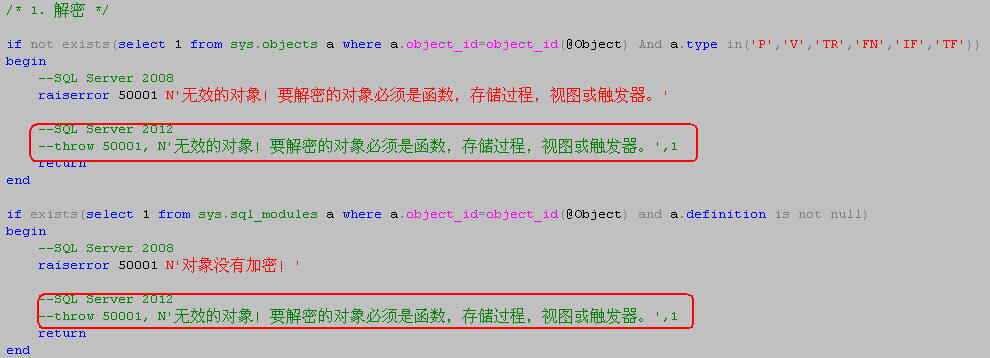
搭建测试环境:
在一个测试环境中(DB: Test),先执行上面的加密存储过程(sp_EncryptObject)和解密存储过程(sp_EncryptObject);再创建两个表:TableA & TableB
use test go --创建表: TableA & TableB if object_id('myTableA') is not null drop table myTableA if object_id('myTableB') is not null drop table myTableB go create table myTableA (ID int identity,data nvarchar(50),constraint PK_myTableA primary key(ID)) create table myTableB (ID int ,data nvarchar(50),constraint PK_myTableB primary key(ID)) go
接下来,我们要创建6个未加密的对象(对象类型包含 'P','V','TR','FN','IF','TF'):
1.视图(myView):
 View Code
View Code2.触发器(MyTrigger):

if object_id('MyTrigger') is not null drop Trigger MyTrigger go create trigger MyTrigger on TableA for update As insert into TableB(ID,data) select a.ID,a.Data From Inserted a go
3.存储过程(MyProc):
 View Code
View Code4.用户定义表值函数(TF)(MyFunction_TF):
 View Code
View Code5.内联表值函数(IF) (MyFunction_IF):
 View Code
View Code6.标量函数(FN)(MyFunction_FN):
 View Code
View Code
当执行完了上面的1-6步骤的脚本,我们通过查询系统视图sys.sql_modules,可以看到未加密前的定义信息:
select b.name as object,b.type,a.definition from sys.sql_modules a inner join sys.objects b on b.object_id=a.object_id where b.create_date>=convert(date,getdate()) order by b.object_id

加密测试:
下面我就通过调用加密存储过程(sp_EncryptObject),一次性对它们进行加密:
use test go exec sp_EncryptObject 'all' go

当我们再查回系统视图sys.sql_modules,会发现definition列返回的是null值,说明定义内容已经给加密:
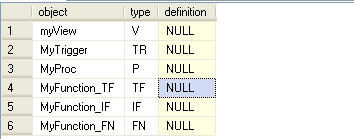
解密测试:
解密过程,必须在DAC连接SQL Server,我们这里例子是从 SSMS(SQL Server Management Studio) 查询编辑器启动 DAC,如图:

解密存储过程(sp_DecryptObject),只能一次对一个存储过程、函数、视图或触发器,进行解密:
use test go exec sp_DecryptObject MyTrigger go

当定义内容长度超过4000,我们可以指定@MaxLength的值,如:
exec sp_DecryptObject fn_My,20000 go
这里(fn_My)是一个函数,定义内容超过了8000:
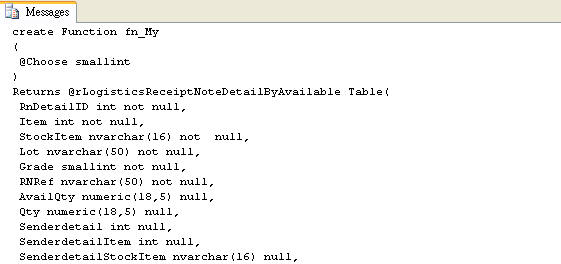
... ...
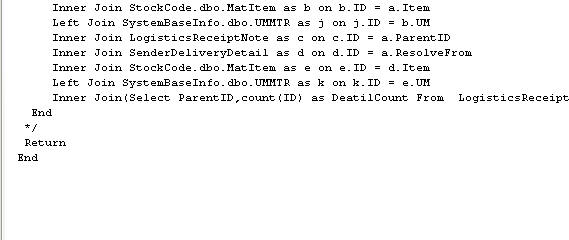
小结:
虽然,上面的脚本,我已经在SQL Server 2008 R2 和SQL Server 2012测试过,但无法避免一些未知错误 。如果你自己在测试上面的脚本,请不要在生产环境上。如果你在应用过程,碰到有什么问题或有什么意见和建议可以发email联系我或跟帖,在此非常感谢!
当SQL Server因系统资源不足,或其它异常导致无法建立数据库连接时, 可以使用系统预留的DAC连接到数据库,进行一些问题诊断和故障排除。DAC只能使用有限的资源。请勿使用DAC运行需要消耗大量资源的查询,否则可能发生严重的阻塞。可在联机帮助中搜索DAC。
建议使用命令行下的sqlcmd连接进去,因为占用的资源更少,连接方法:开始 --> 运行 --> cmd 输入SQLCMD -E -SMQLinstance1 -A&(说明,-A即为指定DAC,其它参数见《联机帮助》)。
使用SQL Server Management Studio建立DAC连接时,服务器一栏输入:admin:主机名\实例名。

如果连接报错: “不支持管理员连接”,英文为:"Cannot connect to admin:SQLSERVER2008R2."
原因为:This is because you can't connect to the DAC in object explorer. You can however connect to it from a query window from management studio click <file> <New Database Engine Query>不能在“对象管理员”中使用DAC进行连接,可以在SQL Server Management Studio的菜单“文件 --> 新建 --> 数据库引擎查询”,再输入admin:主机名\实例名。
如果连接报错:A connection was successfully established with the server, but then an error occurred during the login process. (provider: TCP Provider, error: 0 - The specified network name is no longer available.) (Microsoft SQL Server, Error: 64) 已成功与服务器建立连接,但是在登录过程中发生错误。
原因为已经存在一个活动的DAC连接,不允许建立第二个DAC连接。 这条描述可以在ErrorLog中看到。







【推荐】国内首个AI IDE,深度理解中文开发场景,立即下载体验Trae
【推荐】编程新体验,更懂你的AI,立即体验豆包MarsCode编程助手
【推荐】抖音旗下AI助手豆包,你的智能百科全书,全免费不限次数
【推荐】轻量又高性能的 SSH 工具 IShell:AI 加持,快人一步
· 探究高空视频全景AR技术的实现原理
· 理解Rust引用及其生命周期标识(上)
· 浏览器原生「磁吸」效果!Anchor Positioning 锚点定位神器解析
· 没有源码,如何修改代码逻辑?
· 一个奇形怪状的面试题:Bean中的CHM要不要加volatile?
· 分享4款.NET开源、免费、实用的商城系统
· 全程不用写代码,我用AI程序员写了一个飞机大战
· Obsidian + DeepSeek:免费 AI 助力你的知识管理,让你的笔记飞起来!
· MongoDB 8.0这个新功能碉堡了,比商业数据库还牛
· 白话解读 Dapr 1.15:你的「微服务管家」又秀新绝活了